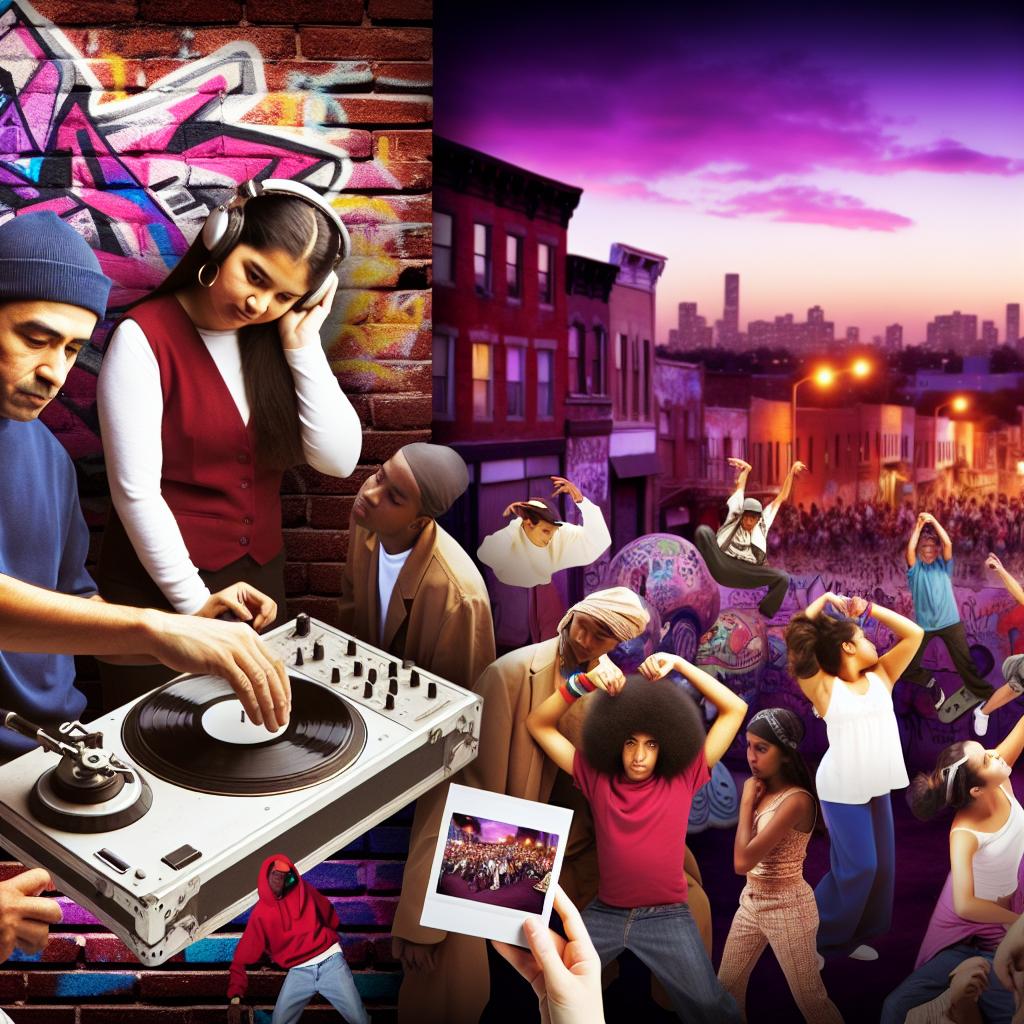The Emergence of Hip Hop Culture
The origins of hip hop culture can be traced back to the early 1970s in the Bronx, New York City. This cultural movement was primarily created by African American, Latino, and Caribbean youth who were influenced by their sociopolitical environment. The term “hip hop” encompasses different forms of expression, including music, dance, art, and fashion.
The Sociocultural Context
During the period when hip hop emerged, the Bronx was characterized by a significant economic decline and urban neglect. Many residents faced poverty, unemployment, and a lack of essential social services. The construction of the Cross Bronx Expressway in the 1950s and 1960s further exacerbated the situation, leading to widespread displacement and housing deterioration. Within this challenging environment, young people sought inventive forms of expression that could articulate their experiences and aspirations.
Musical Roots
The musical facet of hip hop, which later became widely recognized as rap music, owes much to earlier genres. Elements from jazz, blues, and funk were combined with techniques borrowed from Jamaican dub and toasting traditions. A pivotal figure in this development was DJ Kool Herc, a Jamaican immigrant. He is credited with pioneering the use of two turntables to extend the break sections of records, which dancers known as b-boys and b-girls would perform to.
The Role of the DJ
DJs played an essential role in early hip hop culture. By manipulating vinyl records, they created new sounds and energized dance floors at block parties and community gatherings. Alongside DJ Kool Herc, figures like Afrika Bambaataa and Grandmaster Flash were influential in evolving DJ practices. These pioneers developed techniques like scratching and beat juggling, which remain fundamental to hip hop music production today.
The DJ’s role did not merely involve playing music but also acting as a guiding figure in the community, providing a space for expression and dialogue. As hip hop evolved, the DJ’s ability to innovate grew in significance, pushing the boundaries of what could be done with sound.
Visual and Dance Elements
Graffiti and breakdancing are other vital aspects of hip hop culture. Graffiti artists transformed urban landscapes into canvases, expressing social and political themes through vibrant imagery. This art form became known as “writing” and often featured stylized lettering and symbols. Graffiti allowed individuals to make a public statement, to claim space in the urban environment, and to gain recognition from peers.
Breakdancing, also known as breaking, is a street dance style that developed alongside the music. It incorporates acrobatic movements and complex footwork, reflecting the creativity and competitiveness of its practitioners. Breakers often engage in battles, showcasing their skills in a dynamic and public forum. These battles are not just about dance moves; they are cultural exchanges that sustain and develop the art form.
Cultural Impact and Legacy
Initially localized, hip hop culture quickly spread beyond the Bronx, influencing communities worldwide. It provided a voice to marginalized groups and promoted messages of resistance and creativity. As hip hop evolved, it became an integral part of mainstream culture, influencing art, fashion, and language.
The expansion of hip hop across the globe allowed diverse cultures to incorporate its elements while preserving their unique identities. It became a platform for discussing social issues, transcending linguistic and cultural barriers. Hip hop’s adaptability is a testament to its powerful foundation and its ability to inspire a broad audience.
Though it has undergone many transformations, the foundational elements of hip hop remain influential. These elements continue to shape the genres spawned from hip hop’s original sound and ethos. Innovations in technology and communications have only amplified this cultural exchange, allowing new voices to emerge within the hip hop community. To explore more about hip hop’s history and its contributors, various resources are available online, providing deeper insights into this global phenomenon.
Global Adoption and Adaptation
The allure of hip hop has seen it transform from its origins in the Bronx to becoming a dominant form of expression worldwide. Its acceptance in various countries has led to a diversification of its core elements, as local cultures infuse the art form with regionally significant themes and styles, yet the core message of hip hop—a reflection of life’s challenges and victories—remains unchanged.
Economic Repercussions
With hip hop’s rise in popularity, it has also seen significant economic ramifications. The music industry has adapted to its demand, leading to the monetization of its artists and cultural products. This financial success has made hip hop an aspirational genre, providing opportunities beyond artistic expression, including careers in business, fashion, and media.
Bridging Divides
Interestingly, hip hop has served as a bridge across cultural divides. It has played a role in bringing together communities from different ethnic, social, and economic backgrounds, providing a shared space for expression. This bridging power makes hip hop more than just a cultural phenomenon; it is a tool for social change and unity.
Challenges in Representation
However, as hip hop continues to evolve, it faces challenges, particularly regarding authenticity and representation. The commercialization of the genre raises questions about the portrayal of its roots and original values. Ongoing dialogue within the hip hop community helps address these challenges, ensuring that its history and foundational principles are honored.
The emergence of hip hop culture exemplifies the continuous evolution of cultural expression borne from socioeconomic conditions and community resilience. As it grows, hip hop embraces new ideas while maintaining its core, always returning to its roots as a voice for the unheard and a dynamic form of artistic expression. Hip hop’s journey is emblematic of cultural exchange, showing how music and art can break down borders and shape societies.


